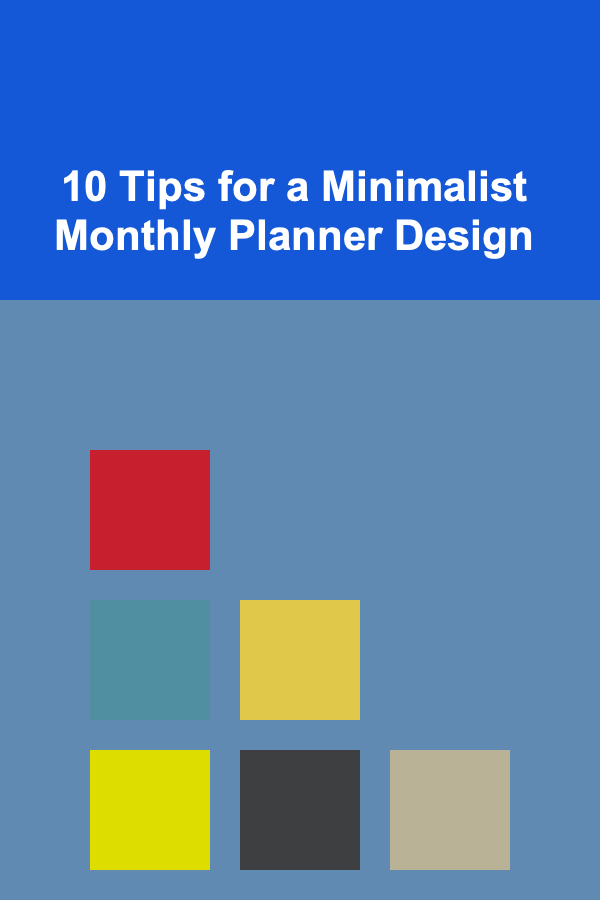
10 Tips for a Minimalist Monthly Planner Design
ebook include PDF & Audio bundle (Micro Guide)
$12.99$11.99
Limited Time Offer! Order within the next:

In today's fast-paced world, the need for organization and structure is more important than ever. Whether you're juggling work, school, or personal commitments, staying on top of your tasks can be a daunting challenge. A monthly planner can be an excellent tool to help you streamline your activities and keep track of your goals. However, in an era where clutter and distractions are prevalent, many people are moving toward minimalist designs. A minimalist monthly planner doesn't just simplify your life; it can also make the process of planning more enjoyable.
A minimalist planner focuses on clean lines, neutral colors, and an emphasis on essential elements. It aims to eliminate distractions and unnecessary features while still offering functionality and creativity. In this article, we'll explore 10 key tips to help you design a minimalist monthly planner that keeps you organized, focused, and efficient.
Keep the Layout Simple and Clear
The first principle of minimalist design is simplicity. When creating a monthly planner, it's essential to choose a layout that is easy to navigate and doesn't overwhelm the user with unnecessary details.
Actions to Take:
- Limit the Number of Sections: Keep it simple by using only the most important sections, such as a calendar grid, to-do lists, and notes.
- Prioritize Space: Ensure that each day or section has enough white space to prevent visual clutter. This helps reduce stress and allows the user to focus only on essential tasks.
- Use Clear Dividers: If you have sections for tasks, goals, or reminders, consider using thin lines or subtle borders to divide them without taking up too much visual space.
Choose a Neutral Color Palette
A minimalist design typically uses neutral, muted colors to create a calm and serene atmosphere. The choice of colors has a significant impact on how functional and aesthetically pleasing the planner will be. Bright colors and patterns can be distracting and take away from the purpose of the planner, which is to focus on your schedule and tasks.
Actions to Take:
- Stick to Two or Three Colors: Limit the color scheme to two or three complementary colors, such as black, white, gray, and a subtle accent color (e.g., navy blue or olive green).
- Use Light Backgrounds: Light-colored backgrounds (like white, cream, or light gray) can provide a clean look that enhances readability and reduces strain on the eyes.
- Accent with Minimal Colors: A soft accent color can be used for highlighting important dates or events without overwhelming the design. Use this sparingly to maintain a sense of simplicity.
Utilize a Grid Structure for Organization
A well-structured grid system is crucial in a minimalist planner. A clean grid layout not only provides clarity but also organizes your time in an intuitive and effective way.
Actions to Take:
- Use Uniform Blocks for Each Day: Ensure that each day has equal-sized blocks for tasks, appointments, and reminders. This symmetry makes it easy to glance at the planner and know where to write.
- Avoid Overcrowding: Allow enough space between each day or task section to maintain clarity. A cluttered grid can defeat the purpose of minimalism.
- Provide Space for Personalization: While grids are essential, leave a small area at the bottom or side for people to add personal notes or creative elements (e.g., inspirational quotes, habit trackers).
Incorporate Clear Typography
Typography is a core aspect of minimalist design. Choosing the right fonts and sizes will ensure your planner is both functional and easy to read.
Actions to Take:
- Use Simple Fonts: Opt for sans-serif fonts like Helvetica, Arial, or Futura, which are clean, modern, and easy to read.
- Limit Font Variations: Use one or two font styles at most. Too many variations (bold, italic, underline) can detract from the minimalist aesthetic.
- Adjust Font Size for Hierarchy: Larger fonts can be used for headings or dates to signify importance, while smaller fonts can be used for the body text or notes section.
Incorporate Ample White Space
White space, or negative space, is an essential element of minimalist design. It not only prevents clutter but also makes the planner feel more open, accessible, and less overwhelming.
Actions to Take:
- Don't Overfill Pages: Resist the urge to fill every inch of the page with content. Instead, leave enough white space around your text and sections to create balance.
- Use Margins Generously: Ensure that there's enough margin around the edges of the page to give the design a breathable feel.
- Allow for Visual Rest: White space provides a mental break and helps the user focus on one task at a time.
Limit the Use of Illustrations and Decorations
While decorations and illustrations can add personality to a planner, minimalist designs focus on functionality over ornamentation. The goal is to avoid distractions and keep the focus on the planner's purpose.
Actions to Take:
- Use Simple Icons: If you do want to include illustrations, opt for minimalist icons such as a small clock for time-related tasks or a simple checkmark for completed tasks.
- Avoid Over-Decorating: Too many decorative elements, such as elaborate borders or illustrations, can clutter the page. Stick to a few simple visual elements that add to the design without overwhelming it.
- Emphasize Functionality: Any additional elements you add, whether it's a monthly overview, habit tracker, or notes section, should serve a clear function and not distract from the primary goal of time management.
Focus on Key Features and Functionality
A minimalist planner isn't about removing features; it's about focusing on the essentials that help you stay organized. Make sure the key sections and features serve their purpose without becoming overly complex.
Actions to Take:
- Keep Track of Essential Information: Prioritize sections like the monthly calendar, daily to-dos, and important deadlines. These are the features you'll use most frequently.
- Create a Simple Goal-Setting Section: If you're interested in tracking personal or professional goals, keep this section concise. Consider breaking down larger goals into smaller, actionable steps.
- Provide Space for Notes and Reflections: Leave room for people to jot down thoughts, reflections, or ideas that may arise throughout the month. This encourages mindfulness and helps the user stay on track.
Include a Minimalist Monthly Overview
A minimalist monthly overview is essential in helping you see the big picture while also providing enough space to plan day-to-day activities. The key is to keep the design uncluttered yet functional.
Actions to Take:
- Create a Grid for Dates: A simple, grid-based monthly calendar layout allows you to see the entire month at a glance. Keep the design straightforward with a header for the month and a grid for each day.
- Use Clear Numbering: Clearly label each date, but avoid additional clutter like lines or dividers that might make the calendar feel too busy.
- Leave Room for Important Events: Ensure that each day's space is large enough to add key appointments or events. Don't overcrowd the days---just a few key items will suffice.
Provide Flexibility for Customization
Minimalist designs often work best when they provide a sense of freedom and adaptability. Allowing users to customize their planners can make them more personal and suited to their unique needs.
Actions to Take:
- Use Blank Spaces for Personalization: While the core structure should be consistent, leave some areas blank for the user to add their own creative touches, such as habit trackers or a personal reflection section.
- Consider Modular Sections: A modular design, where users can add or remove specific sections (e.g., habit tracking, mood tracking, weekly goals), gives the planner flexibility while keeping it minimalist.
- Allow for Free-Form Notes: A dedicated notes section without strict guidelines or prompts lets users write freely and customize the planner based on their needs.
Choose a Durable and High-Quality Material
Even though the design is minimalist, the material of your planner is just as important. A high-quality material ensures the longevity and functionality of the planner, making it a tool you'll want to keep using month after month.
Actions to Take:
- Use Sturdy Paper: Choose thick, high-quality paper that feels smooth to write on and prevents ink from bleeding through.
- Opt for a Simple Cover: The cover should reflect the minimalist design, with clean lines and perhaps a subtle logo or design element. Leather or hardcover materials are durable and sophisticated.
- Consider a Flexible Binding: A simple yet durable binding method, such as wire-o or perfect binding, can provide flexibility while ensuring that the planner holds together over time.
Conclusion
A minimalist monthly planner is about more than just aesthetics; it's about creating a functional and calming space where you can focus on the things that matter most. By following these 10 tips, you can design a planner that keeps your schedule organized without overwhelming you with clutter. A minimalist approach encourages simplicity, functionality, and creativity, allowing you to focus on what's important while maintaining a peaceful, efficient system for your life. With clean layouts, neutral color schemes, and clear typography, a minimalist planner is the perfect tool for those who want to streamline their month while reducing stress.
Reading More From Our Other Websites
- [Hiking with Kids Tip 101] Exploring Trails with Kids: The Best Hiking Apps for Young Adventurers
- [Home Maintenance 101] How to Perform Seasonal Maintenance to Keep Your Home Safe
- [Home Holiday Decoration 101] How to Install Christmas Lights Like a Pro
- [Organization Tip 101] How to Plan a Minimalist Vacation with Essential Packing
- [Home Holiday Decoration 101] How to Decorate Your Holiday Fireplace Mantel for a Cozy, Warm Feel
- [Organization Tip 101] How to Develop a Cleaning Schedule for Volunteer Areas
- [Home Party Planning 101] Best Ideas for a Home Party That's Both Fun and Focused on Quality Time
- [Home Cleaning 101] How to Revive Old Curtains and Drapes with Simple Cleaning Methods
- [Organization Tip 101] How to Sort Family Photos by Year and Event
- [Stamp Making Tip 101] Design Tips and Tool Essentials for Mastering Wood Block Stamps

How to Design a Family Fitness Routine for All Ages
Read More
How to Maintain Your Home's Lighting Fixtures for Longevity
Read More
How to Make Money Online as a Surgeon: 10 Actionable Ideas
Read More
Why You Should Create an Inventory of Your Belongings
Read More
How to Plan Your Estate While Living Abroad
Read More
10 Tips for Running a Faster 5K
Read MoreOther Products

How to Design a Family Fitness Routine for All Ages
Read More
How to Maintain Your Home's Lighting Fixtures for Longevity
Read More
How to Make Money Online as a Surgeon: 10 Actionable Ideas
Read More
Why You Should Create an Inventory of Your Belongings
Read More
How to Plan Your Estate While Living Abroad
Read More